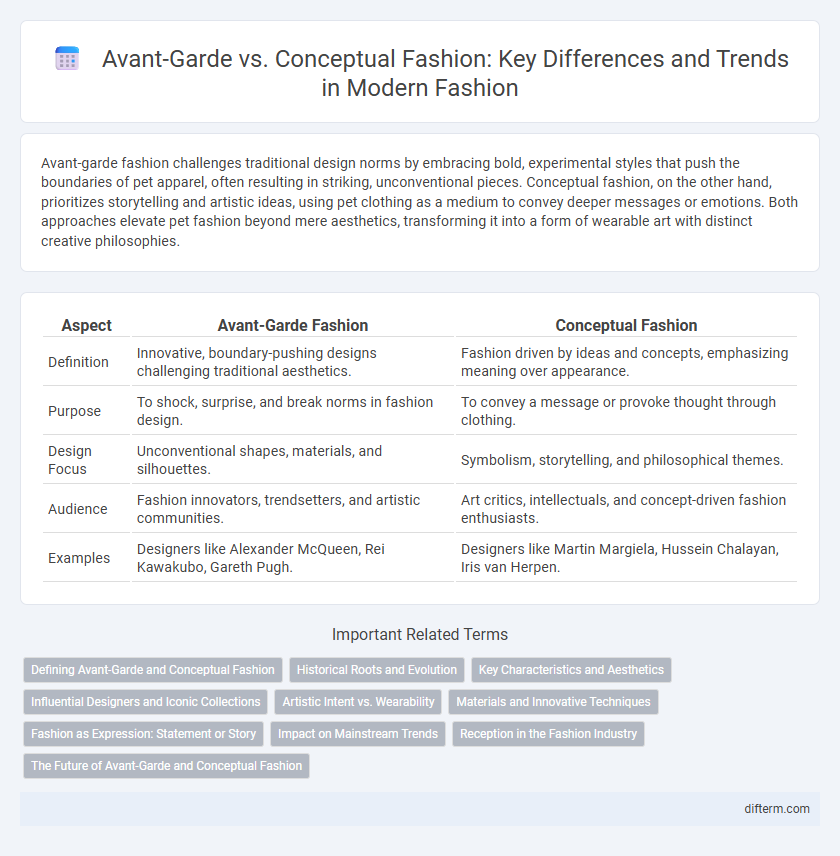Avant-garde fashion challenges traditional design norms by embracing bold, experimental styles that push the boundaries of pet apparel, often resulting in striking, unconventional pieces. Conceptual fashion, on the other hand, prioritizes storytelling and artistic ideas, using pet clothing as a medium to convey deeper messages or emotions. Both approaches elevate pet fashion beyond mere aesthetics, transforming it into a form of wearable art with distinct creative philosophies.
Table of Comparison
| Aspect | Avant-Garde Fashion | Conceptual Fashion |
|---|---|---|
| Definition | Innovative, boundary-pushing designs challenging traditional aesthetics. | Fashion driven by ideas and concepts, emphasizing meaning over appearance. |
| Purpose | To shock, surprise, and break norms in fashion design. | To convey a message or provoke thought through clothing. |
| Design Focus | Unconventional shapes, materials, and silhouettes. | Symbolism, storytelling, and philosophical themes. |
| Audience | Fashion innovators, trendsetters, and artistic communities. | Art critics, intellectuals, and concept-driven fashion enthusiasts. |
| Examples | Designers like Alexander McQueen, Rei Kawakubo, Gareth Pugh. | Designers like Martin Margiela, Hussein Chalayan, Iris van Herpen. |
Defining Avant-Garde and Conceptual Fashion
Avant-garde fashion pushes the boundaries of traditional design through radical, experimental aesthetics that challenge mainstream norms, often featuring unconventional materials and exaggerated forms. Conceptual fashion centers on conveying a specific idea or message, prioritizing intellectual engagement over wearability, frequently seen in collections that emphasize narrative, symbolism, or social critique. Both genres redefine fashion as an art form, with avant-garde focusing on innovation in form and concept-driven fashion emphasizing storytelling and meaning.
Historical Roots and Evolution
Avant-garde fashion emerged in the early 20th century as a radical response to traditional aesthetics, characterized by experimental designs that challenge conventional norms. Conceptual fashion, gaining prominence in the late 20th century, emphasizes ideas and narratives over garments, often blurring the line between art and clothing. Both movements trace their evolution through key designers like Elsa Schiaparelli for avant-garde and Martin Margiela for conceptual fashion, shaping contemporary avant-garde and boundary-pushing runway presentations.
Key Characteristics and Aesthetics
Avant-garde fashion is characterized by its radical innovation, unconventional silhouettes, and boundary-pushing designs that challenge mainstream aesthetics, often incorporating experimental materials and techniques. Conceptual fashion prioritizes ideas and narratives over wearability, emphasizing symbolism, artistic expression, and intellectual engagement through abstract forms and thought-provoking themes. Both styles disrupt traditional fashion norms but avant-garde focuses on visual disruption, while conceptual fashion centers on deeper meaning and commentary.
Influential Designers and Iconic Collections
Influential designers like Rei Kawakubo and Iris van Herpen have redefined avant-garde fashion through their boundary-pushing collections that challenge traditional aesthetics and emphasize innovation. Conceptual fashion, championed by designers such as Martin Margiela and Viktor & Rolf, focuses on the ideas and narratives behind garments, showcasing iconic collections that provoke thought and redefine the purpose of clothing. These designers have cemented their legacies by blending artistry with craftsmanship, influencing both contemporary fashion and cultural discourse.
Artistic Intent vs. Wearability
Avant-garde fashion pushes the limits of artistic expression with bold, unconventional designs that challenge traditional aesthetics, prioritizing creativity over practicality. Conceptual fashion emphasizes the underlying ideas and narratives, often using symbolic elements to provoke thought rather than focusing on everyday wearability. Wearability takes a backseat in both avant-garde and conceptual fashion, positioning these styles as art forms intended to inspire and question rather than serve as mainstream apparel.
Materials and Innovative Techniques
Avant-garde fashion often employs unconventional materials like industrial plastics or recycled metals, pushing the boundaries of texture and form through 3D printing and laser-cutting techniques. Conceptual fashion prioritizes materials with symbolic meaning or sustainability, using organic fibers and biodegradable textiles enhanced by experimental dyeing and fabric manipulation methods. Both styles drive innovation by merging material science with cutting-edge craftsmanship to challenge traditional garment construction.
Fashion as Expression: Statement or Story
Avant-garde fashion challenges conventional aesthetics, using bold shapes and unconventional materials to make a striking statement that disrupts traditional style norms. Conceptual fashion, on the other hand, prioritizes storytelling and ideas over wearability, often embedding social commentary or philosophical themes within the garment's design. Both approaches transform clothing into powerful mediums of self-expression, where avant-garde emphasizes visual impact and conceptual fashion conveys deeper narratives.
Impact on Mainstream Trends
Avant-garde fashion challenges conventional aesthetics by introducing experimental designs that push boundaries, often influencing mainstream trends through bold innovation and artistic expression. Conceptual fashion prioritizes ideas and narratives over wearable practicality, impacting mainstream markets by inspiring designers to incorporate deeper meaning and storytelling into commercial collections. Both styles serve as catalysts for evolution in fashion, driving consumer interest toward more creative and thought-provoking apparel.
Reception in the Fashion Industry
Avant-garde fashion is often celebrated for its bold innovation and boundary-pushing aesthetics, receiving acclaim from designers and critics for challenging conventional norms. Conceptual fashion, while less commercial, garners respect within niche circles for its intellectual depth and artistic expression, frequently showcased in art galleries and academic discussions. Both styles influence mainstream trends by inspiring experimentation and expanding the definitions of wearable art in the fashion industry.
The Future of Avant-Garde and Conceptual Fashion
The future of avant-garde and conceptual fashion lies in the fusion of cutting-edge technology and sustainable materials, pushing creative boundaries beyond traditional aesthetics. Designers increasingly incorporate 3D printing, smart textiles, and virtual reality to create immersive, transformative garments that challenge conventional notions of wearability. This evolution not only redefines fashion innovation but also emphasizes environmental responsibility and experiential design in the industry's next frontier.
Avant-garde vs conceptual fashion Infographic

 difterm.com
difterm.com